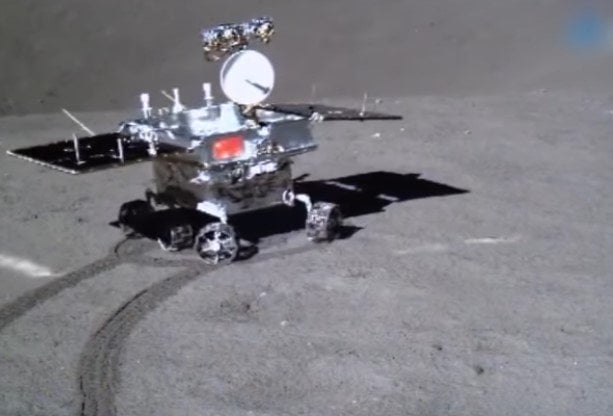The Chinese robot known as Yutu 2 and the lander which transported it to the moon have has woken up after its first lunar night. According to the China National Space Administration (CNSA) the rover is in a good state after surviving about two weeks at its Von Kármán Crater landing site. Now that the lunar day has started again on the far side of the moon, the little rover can continue collecting data and information on the lunar surface.
According to the Xinhua news agency, CNSA announced that its Chang’e 4 lander and Yutu 2 rover both survived the frigid temperatures which came with night on the moon. The rover woke up from sleep mode at around 7 a.m. Eastern on Tuesday, and the lander woke up 24 hours later.
CNSA officials were previously worried that the extremely cold temperatures could affect the lander and rover. However, they have now announced that everything is in a stable state and that communication and data are being transmitted between Earth and the lander on the moon via the relay satellite Queqiao.
The wake-up process didn’t require any manual control. Instead, the Chinese robot woke up automatically after sensing the change in the angle of the sunlight touching the far side of the moon. The Von Kármán Crater landing crater is actually part of the giant South Pole-Aitken Basin. Mission officials also said the key instruments used for their research have started working normally. The rover is located about 60 feet away from the lander.
The first lunar night enabled CNSA officials to get a better understanding of the moon’s rotation and cycles. Data based on measurements captured by Chang’e 4 showed that the temperature of the lunar soil on the far side of the moon is considerably lower than the temperatures recorded by the U.S. Apollo mission on the closer side of the moon, according to Zhang He, executive director of the Chang’e 4 probe project from the China Academy of Space Technology (CAST), as reported by Xinhua.
“That’s probably due to the difference in lunar soil composition between the two sides of the moon. We still need more careful analysis,” Zhang added.
The lander is also equipped with an isotope thermoelectric cell and temperature data collectors, which will help measure temperatures on the surface of the moon during lunar night. The instruments have already captured a temperature of -310 degrees Fahrenheit during the first lunar night, according to China’s Global Television Network (CGTN.)
Before the first lunar night, the Chinese robot used its container to plant the first cotton plant on the moon. The seeds sprouted, while other plants contained in the container also promised to sprout. However, since the Chinese lander entered sleep mode during the lunar night, it didn’t keep the temperature warm enough for the plants to continue growing on the moon.





